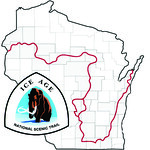The term ventifact is derived from "ventus," which is a Latin for wind. Defined by their smoother, flattened or faceted surfaces and sharp ridges or edges.
The origin of these ventifacts began when the Wisconsin glaciation covered much of North American about 60,000 years ago. They are stones that have one or more flattened facet that is highly polished. They are produced under arid conditions by windblown sand. Ventifacts are generally formed from hard, fine-grained rocks such as obsidian, chert, or quartzite. Since the Baraboo Hills are primarily quartzite, that is also the primary stone of the ventifacts in the area. They are fairly common on surfaces just outside the ice margin of the Late Wisconsin glacier; (eg driftless areas). There was little or no vegetation while the ice was nearby, but the glacier did bring and create lots of sand which was blown by the wind. In the arctic climates that existed when the glacier was here, ice particles may also have been involved in the shaping of the rock. Ventifacts can range from centimeter-sized pebbles to large rocks and boulders.
As the particles collide with the rock, the rock is smoothed and flattened on the windward side. A ventifact may have more than one scoured facet. The formation of multiple faceted ventifacts could be created because the rock moves as the wind removes sediment from underneath and positions the rock so another side faces the prevailing wind. They could also be caused by a change in wind direction due to seasonal or climatic factors.
All ventifacts are formed in environments that have large amounts of fine particles (usually sand, silt, and / or ice) which act as an abrasive. There must also be low precipitation, sparse vegetation, and strong winds that blow in the same direction for a very long time. Even the distribution of the rocks can affect the wind and therefore the formation of each individual ventifact. The Pleistocene era is believed to have had strong winds that changed directions seasonally.
 IATCC is the cache designation to highlight a series of EarthCaches along the Ice Age National Scenic Trail grouped into a special category called "ColdCache."
IATCC is the cache designation to highlight a series of EarthCaches along the Ice Age National Scenic Trail grouped into a special category called "ColdCache."
The Ice Age Trail is one of eleven National Scenic Trails designated by the National Park Service. This unique trail is entirely within the state of Wisconsin and follows along the terminal moraine of the most recent glacier which retreated about 10,000 years ago.
This project is supported by the Ice Age Trail Alliance (IATA). The goal is to bring more visitors to the trail and promote public awareness, appreciation, and understanding of Wisconsin’s glacial landscape.
The IATA has created an awards program to encourage visits to the trail and ColdCache sites. This awards program is separate from, and in addition to, any other Geo- or EarthCache awards program.
A current list of approved ColdCache sites can be found on the “IATCC Bookmark List”. More information on the Ice Age Trail Atlas, the Companion Guide, the ColdCache Project and Awards Program can be found on the “ColdCache Webpage”
Resources
Encyclopedia Britannica
Geology of the Ice Age National Scenic Trail; by David M. Mickelson, Louis J. Mahler Jr., and Susan L. Simpson
Long Island Pleistocene Ventifacts; a website by Zak Ettlinger
DNR Permission
The Geocache Notification Form has been submitted to Steve Schmelzer of the Wisconsin DNR. Geocaches placed on Wisconsin Department of Natural Resource managed lands require permission by means of a notification form. Please print out a paper copy of the notification form, fill in all required information, then submit it to the land manager. The DNR Notification form and land manager information can be obtained at: www.wi-geocaching.com/hiding
To claim this find:
Look for rocks at the following three locations:
Site 1: N43 25.612 W089 40.968 (6-8 feet to north-east side of trail)
Site 2: N43 25.540 W089 40.851 (2-3 feet to south-west side of trail)
Site 3: N43 25.535 W089 40.846 (4-5 feet to east of trail
1. Which direction is the flat, polished surface of each facing?
2. Based on this information, from which direction do you think the wind was mostly coming from during the Pleistocene era?
3. Do you suspect that any of the rocks were moved? If so, which one(s) and why?